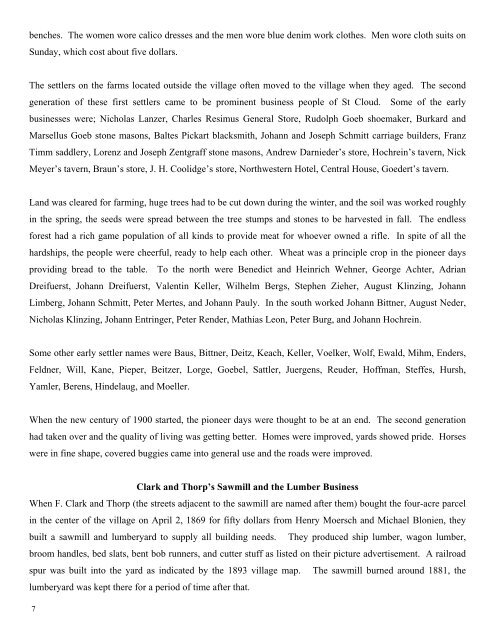Historical Notes And Photos Of St Cloud, Wisconsin - Village of Saint ...
Historical Notes And Photos Of St Cloud, Wisconsin - Village of Saint ...
Historical Notes And Photos Of St Cloud, Wisconsin - Village of Saint ...
You also want an ePaper? Increase the reach of your titles
YUMPU automatically turns print PDFs into web optimized ePapers that Google loves.
enches. The women wore calico dresses and the men wore blue denim work clothes. Men wore cloth suits onSunday, which cost about five dollars.The settlers on the farms located outside the village <strong>of</strong>ten moved to the village when they aged. The secondgeneration <strong>of</strong> these first settlers came to be prominent business people <strong>of</strong> <strong>St</strong> <strong>Cloud</strong>. Some <strong>of</strong> the earlybusinesses were; Nicholas Lanzer, Charles Resimus General <strong>St</strong>ore, Rudolph Goeb shoemaker, Burkard andMarsellus Goeb stone masons, Baltes Pickart blacksmith, Johann and Joseph Schmitt carriage builders, FranzTimm saddlery, Lorenz and Joseph Zentgraff stone masons, <strong>And</strong>rew Darnieder’s store, Hochrein’s tavern, NickMeyer’s tavern, Braun’s store, J. H. Coolidge’s store, Northwestern Hotel, Central House, Goedert’s tavern.Land was cleared for farming, huge trees had to be cut down during the winter, and the soil was worked roughlyin the spring, the seeds were spread between the tree stumps and stones to be harvested in fall. The endlessforest had a rich game population <strong>of</strong> all kinds to provide meat for whoever owned a rifle. In spite <strong>of</strong> all thehardships, the people were cheerful, ready to help each other. Wheat was a principle crop in the pioneer daysproviding bread to the table. To the north were Benedict and Heinrich Wehner, George Achter, AdrianDreifuerst, Johann Dreifuerst, Valentin Keller, Wilhelm Bergs, <strong>St</strong>ephen Zieher, August Klinzing, JohannLimberg, Johann Schmitt, Peter Mertes, and Johann Pauly. In the south worked Johann Bittner, August Neder,Nicholas Klinzing, Johann Entringer, Peter Render, Mathias Leon, Peter Burg, and Johann Hochrein.Some other early settler names were Baus, Bittner, Deitz, Keach, Keller, Voelker, Wolf, Ewald, Mihm, Enders,Feldner, Will, Kane, Pieper, Beitzer, Lorge, Goebel, Sattler, Juergens, Reuder, H<strong>of</strong>fman, <strong>St</strong>effes, Hursh,Yamler, Berens, Hindelaug, and Moeller.When the new century <strong>of</strong> 1900 started, the pioneer days were thought to be at an end. The second generationhad taken over and the quality <strong>of</strong> living was getting better. Homes were improved, yards showed pride. Horseswere in fine shape, covered buggies came into general use and the roads were improved.Clark and Thorp’s Sawmill and the Lumber BusinessWhen F. Clark and Thorp (the streets adjacent to the sawmill are named after them) bought the four-acre parcelin the center <strong>of</strong> the village on April 2, 1869 for fifty dollars from Henry Moersch and Michael Blonien, theybuilt a sawmill and lumberyard to supply all building needs. They produced ship lumber, wagon lumber,broom handles, bed slats, bent bob runners, and cutter stuff as listed on their picture advertisement. A railroadspur was built into the yard as indicated by the 1893 village map. The sawmill burned around 1881, thelumberyard was kept there for a period <strong>of</strong> time after that.7


